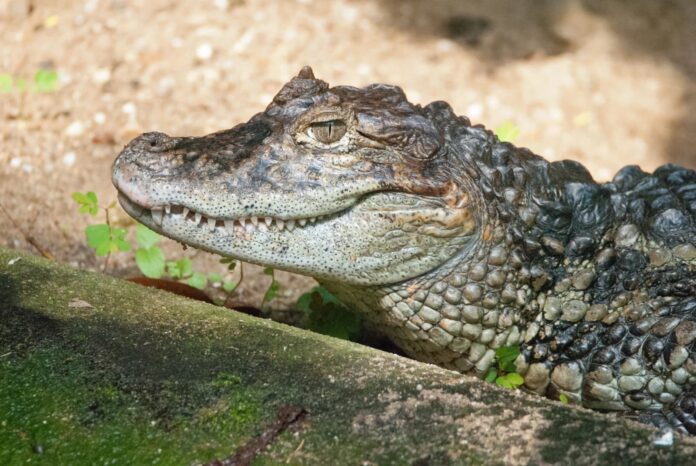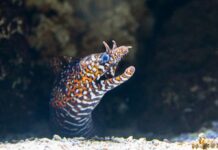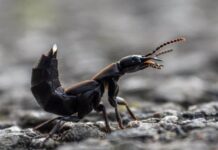Caiman is one of the members of the Alligatoridae family, but they are neither crocodile nor alligator. There are 6 caiman species in the world, and they also look different from crocodiles. Though quite similar, you can tell a caiman apart from a crocodile by its broader snout. Along with that, a caiman’s lower teeth are not visible when it closes its jaws. You will be able to tell more about the differences after reading about each of the caiman species below. Shall we?
1Black Caiman
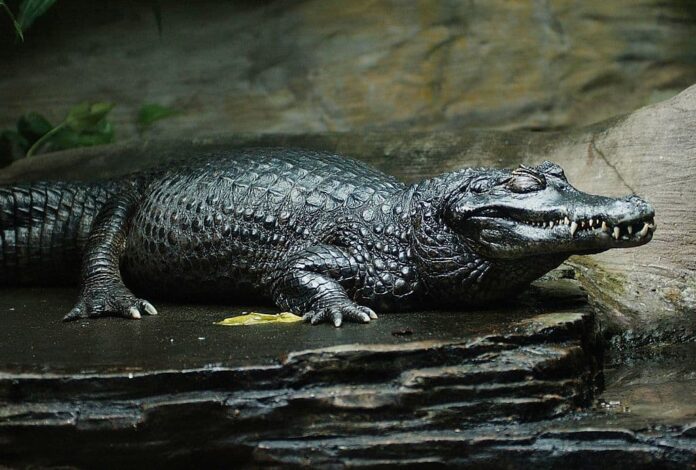
Scientific Name: Melanosuchus Niger
A black caiman is massive, reaching a length of around 5 meters up to 6.5 meters long. Just like the name suggests, the black caiman has a dark greenish-black coloration which helps with camouflage while hunting. The skin is thick and scaly, making a very strong armor; as if it needs any protection as an apex predator. It has a large and heavy head with large eyes and a prominent nose at the top. That way, the crocodilian is able to see and breathe while the rest of the body is hiding underwater. Being one of the largest caiman species, it has big jaws that can chomp on anything in its way.
The black caiman is endemic to South America, inhabiting freshwater habitats such as lakes, seasonally flooded savannas, and slow-moving rivers. It is also very common to see these fearsome predators in swamps and wetlands. As the largest predators in the Amazon basin, they feed on pretty everything, even other caimans and smaller caimans of their own kind. Some of the main meals on the menu are Amazon river dolphins, anacondas, capybara, deer, giant otters, peccaries, piranhas, tapirs, etc. If the prey is small, it will swallow the meal whole after the attack. Should the prey be large, it will drag the prey into deep waters and drown it first. Then it will wait for the decomposition to start so the tissues are softened for easier consumption.
No matter how large an animal is, it still falls prey to humans and was hunted to near extinction once. Humans hunt black caiman for leather or meat, while habitat destruction plays another part in pushing their population down. While their status is still stable, their numbers have been depleting in a few countries already. Without proper conservation and protection, history will repeat itself.
2Broad-Snouted Caiman
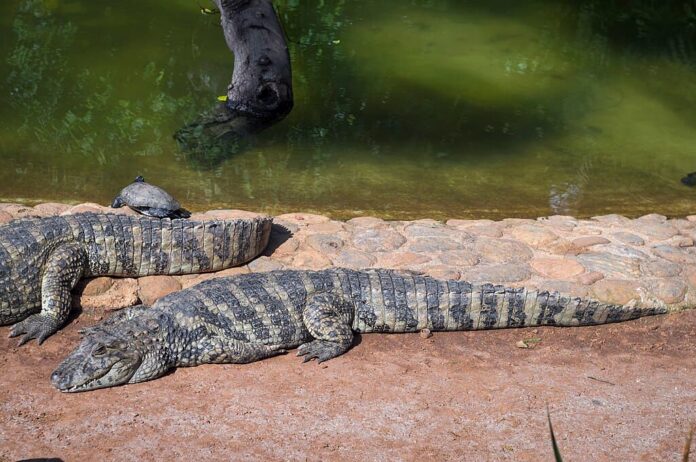
Scientific Name: Caiman Latirostris
With a maximum length of 3.5 meters, this is the second-largest caiman species after the black caiman. A broad-snouted caiman is light olive-green in color, and some individuals have spots on their faces. While other caimans are gifted with armor, this one has soft hides which are not so protective. As the name already suggests, its distinctive feature is the broad snout that is as broad as its head. The snout of this caiman species is broader than that of other species, and it helps with ripping through the dense vegetation of the marshes.
The range of the broad-snouted caiman extends across Eastern and Central South America, inhabiting freshwater wetlands. It is very common to find them in floodplains, lakes, mangrove forests, marshes, ponds, rivers, streams, and swamps. Young ones feed on arachnids and beetles while adults prey on birds, large fish, reptiles, small mammals, snails, and turtles. The powerful jaws of these caimans enable them to effortlessly crush crustacean carapaces and mollusk shells. Having the softest hides puts them at risk of being hunted for their skin. Humans poached them to near extinction in the early 90s, but they made a comeback thanks to the conservative programs.
3Dwarf Caiman
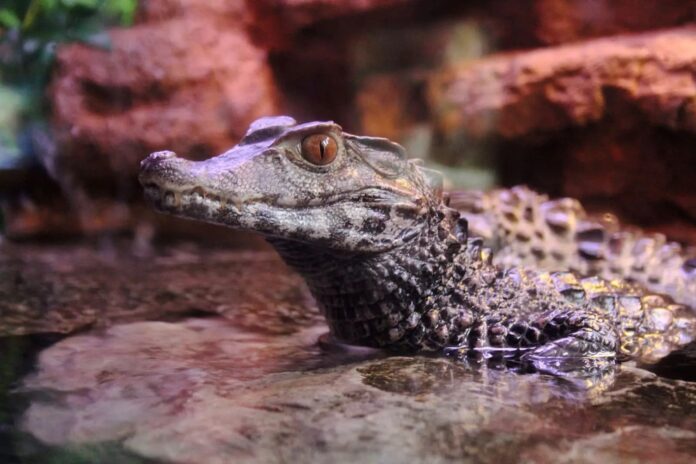
Scientific Name: Paleosuchus Palpebrosus
Here you are looking at the smallest caiman species, growing up to only 1.6 meters long maximum. Its small body is reddish-brown in color, and there are encircling bands on its tail. Being small does not necessarily mean disadvantage; it has a very strong armor on its back and stomach. This alone can protect the small reptiles against predators to some extent. One of the unique features of this caiman is its unusual head shape. The skull is dome-shaped while the snout is short, smooth, and concave with an upturned tip. Some said the head shape of the dwarf caiman resembles the head of a dog. But don’t let this dog-like appearance fool you, it is an ambush predator in its territory.
Dwarf caimans are native to tropical northern and central South America, ranging across various habitats. This freshwater caiman species lives in flooded forests around lakes, riverine forests, and near fast-flowing rivers and streams. Across their habitats, they feed on a wide variety of prey including amphibians, birds, fish, insects, invertebrates, mollusks, and small mammals. A dwarf caiman usually swallows its prey whole or in large pieces. Since it is far from an apex predator, this caiman species does have a few predators of its own. Its hatchling and young lives are taken out by birds, rodents, and snakes while adults are preyed on by large boas, green anacondas, and jaguars.
It is true that their population is stable in the wild, but their numbers are still slowly decreasing. The common threats are illegal hunting and poaching, along with mining agriculture and other forms of human expansion. However, the biggest threats to their population are habitat destruction and pollution, and things are not getting better.
4Smooth-Fronted Caiman
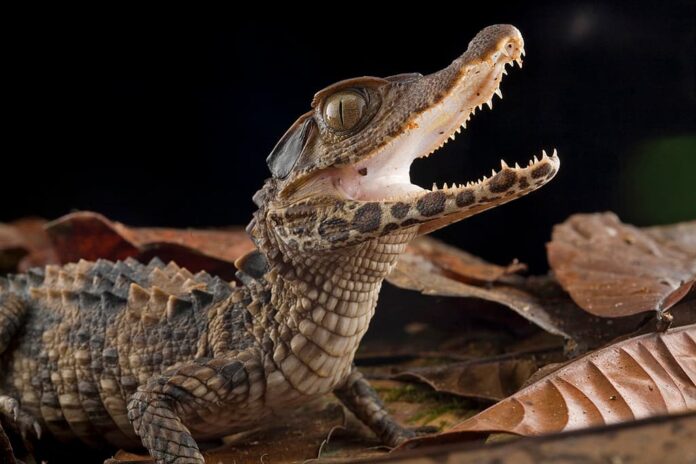
Scientific Name: Paleosuchus Trigonatus
Also goes by the name Schneider’s smooth-fronted caiman, it is also the second smallest caiman species. A smooth-fronted caiman can reach a length of 1.8 meters, and the maximum length is 2.3 meters. Its elongated body is dark grayish-brown, and it is a robust reptile that carries its head high to track prey more efficiently. While other caiman species have armor on their bodies, this one even has one on its neck and tail. There are triangular scutes on the back of its neck and tail, and these scutes are large and sharp. The bony scutes on a smooth-fronted caiman’s tail have sideways projections, making that tail dangerous. And on top of that, it possesses arboreal capabilities as it is able to climb trees and bushes. So if you think that crocodilians can’t climb trees, think again.
Smooth-fronted caimans are native to the Amazon and Orinoco Basins in South America, inhabiting small streams in forested areas. They are quite elusive, and they hide in underwater burrows, hollow logs, or under fallen trees during the day. When they do come out to hunt, they go for prey such as birds, fish, lizards, pacas, porcupines, and snakes. The good thing about having bony scutes is that it does not only provide protection but also keep hunters away. Humans don’t really hunt this caiman species because the bony scutes are not ideal for hunting for leather. However, their population is still affected by habitat destruction, pollution, and collection for the pet trade.
5Spectacled Caiman
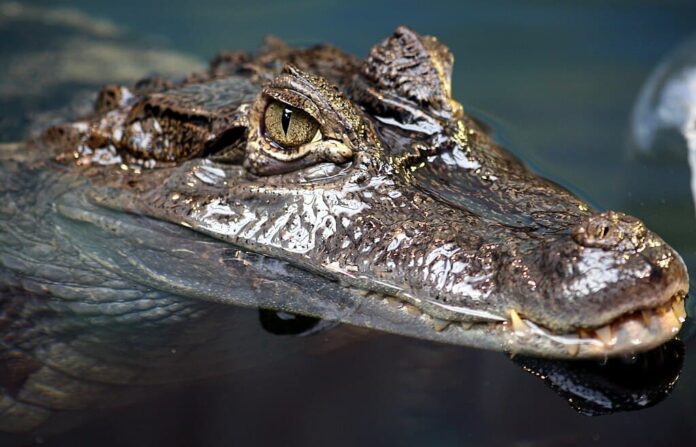
Scientific Name: Caiman Crocodilus
Spectacled caiman aka common caiman and white caiman, is a caiman species with a very interesting appearance. It has a spectacled-like ridge between its beautiful green eyes; hence the name. A spectacled caiman is brownish, greenish, or yellowish-gray in color, with vaguely dark crossbands on its body and tail. This semiaquatic reptile grows to a length of 2.5 meters long, and its bulky body is armored with scales. You see those muscly legs? They allow these caimans to move rapidly when threatened or when they want to chase you for fun. However, they don’t really do that as they like to spend their time resting on shores or partly in water.
The spectacled caimans are native to Latin America but they also have a large range and population in other areas. In fact, they have the largest range of any caiman species out there, so much so that they become an invasive species in South Florida. Their common habitats are forests, grasslands, inland bodies of fresh water, savannas, and shrublands. They hunt at night, and they have excellent night vision thanks to the Müller glial cells in their eyes. Their diet consists of amphibians, birds, crabs, crustaceans, fish, mammals, reptiles, snails, and more.
Spectacled caimans are the most heavily harvested species by humans for the hide industry. Considering their abundant number and large range, their population is doing really well. In many areas, they are potentially dangerous to humans and pets, and they also attack livestock.
6Yacare Caiman

Scientific Name: Caiman Yacare
Probably not commonly known by people, a yacare caiman is one of the larger members of the family. It reaches a length of 2 to 3 meters, taking up to 15 years to finally finish its growth. A yacare caiman has dark marks across its body, and even areas around its lower jaw are covered with blotches. With the nickname piranha caiman, it sounds like it is about this reptile’s diet. However, it is more about their teeth on their lower jaw that can poke through holes in their upper jaw.
Yacare caiman is endemic to Argentina, Bolivia, Brazil, and Paraguay, inhabiting lakes, rivers, and wetlands deep in the jungles. In those habitats, they usually feed on fish and snails, which they swallow whole, as well as other vertebrates and snakes. Despite the scaly skin, the younger ones still fall prey to jaguars. Having a limited range, the population of yarace caiman is threatened by the construction of dams and seaports, deforestation, illegal hunting, and tourism. Humans also still hunt them for their skin to make leather.
Related Post: Most Dangerous Crocodiles

